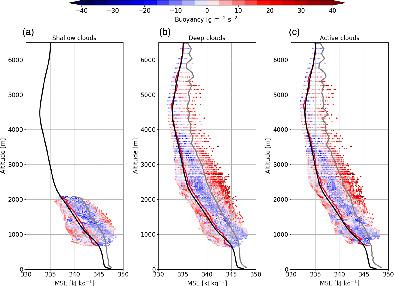当前位置:
X-MOL 学术
›
Q. J. R. Meteorol. Soc.
›
论文详情
Our official English website, www.x-mol.net, welcomes your
feedback! (Note: you will need to create a separate account there.)
Formation and maintenance of subsiding shells around non‐precipitating and precipitating cumulus clouds
Quarterly Journal of the Royal Meteorological Society ( IF 3.0 ) Pub Date : 2020-11-01 , DOI: 10.1002/qj.3942 Julien Savre 1
Quarterly Journal of the Royal Meteorological Society ( IF 3.0 ) Pub Date : 2020-11-01 , DOI: 10.1002/qj.3942 Julien Savre 1
Affiliation

|
A shell of subsiding air is generally known to develop around cumulus clouds and shield them from their environment. We seek here to improve our understanding of such shells by (a) revealing the detailed vertical and horizontal structure of shells surrounding both shallow and deeper clouds, and (b) identifying the mechanisms responsible for in‐shell subsidence generation and maintenance. To that end, a high‐resolution Cloud Resolving Model simulation of the shallow‐to‐deep convection transition over a tropical land surface is analysed with an emphasis on the cloud's near environment. Shells surrounding shallow and deep clouds are found to possess surprisingly similar characteristics. However important differences are observed near cloud top where the deepest clouds are associated with stronger subsidence and broader shells. In the convective outflow region, stronger in‐shell subsidence coincides with strong buoyancy reversal, but also with strong pressure gradients naturally generated by cloud‐top vortex dynamics. A more delicate balance between various processes takes place below, and in‐shell subsidence is only barely sustained as buoyancy reversal is largely compensated by pressure gradients. Finally, while evaporation is clearly the main source of buoyancy reversal everywhere around cloud edges, it is also shown that the downward transport of warmer air from aloft through the subsiding shells may compensate for evaporative cooling to slowly bring in‐shell buoyancy to a near‐neutral state. Overall, while it cannot be denied that evaporative cooling and buoyancy reversal play important roles in generating and sustaining in‐shell subsidence, the present results also emphasise that mechanical forcing at cloud top and downward transport within the shells should not be overlooked.
中文翻译:

非降水和积云周围沉降壳的形成和维持
众所周知,沉陷的空气壳会在积云周围形成并使其免受周围环境的影响。我们在此寻求通过(a)揭示围绕浅层云层和深层云层的壳的详细的垂直和水平结构,以及(b)识别负责壳内沉降生成和维护的机制,来增进对此类壳的理解。为此,分析了热带陆地表面上由浅到深的对流转变的高分辨率云解析模型模拟,重点是云的近环境。发现围绕浅云层和深云层的壳具有令人惊讶的相似特征。然而,在云顶附近观察到重要差异,在云顶附近,最深的云层与更强的沉降和更宽的壳层相关。在对流外流区,较强的壳内沉降与强烈的浮力逆转同时发生,同时也与云顶涡旋动力学自然产生的强压力梯度相吻合。下面,各种过程之间实现了更为精细的平衡,并且由于浮力的逆转在很大程度上由压力梯度所补偿,因此壳内沉降几乎无法维持。最后,尽管蒸发显然是云边缘周围到处浮力反转的主要来源,但也表明,较高的空气从高空向下通过沉降壳的传输可能补偿了蒸发冷却,从而使壳内浮力逐渐接近。中立状态。总体而言,尽管不能否认蒸发冷却和浮力逆转在产生和维持壳内沉陷中起着重要作用,
更新日期:2020-11-01
中文翻译:

非降水和积云周围沉降壳的形成和维持
众所周知,沉陷的空气壳会在积云周围形成并使其免受周围环境的影响。我们在此寻求通过(a)揭示围绕浅层云层和深层云层的壳的详细的垂直和水平结构,以及(b)识别负责壳内沉降生成和维护的机制,来增进对此类壳的理解。为此,分析了热带陆地表面上由浅到深的对流转变的高分辨率云解析模型模拟,重点是云的近环境。发现围绕浅云层和深云层的壳具有令人惊讶的相似特征。然而,在云顶附近观察到重要差异,在云顶附近,最深的云层与更强的沉降和更宽的壳层相关。在对流外流区,较强的壳内沉降与强烈的浮力逆转同时发生,同时也与云顶涡旋动力学自然产生的强压力梯度相吻合。下面,各种过程之间实现了更为精细的平衡,并且由于浮力的逆转在很大程度上由压力梯度所补偿,因此壳内沉降几乎无法维持。最后,尽管蒸发显然是云边缘周围到处浮力反转的主要来源,但也表明,较高的空气从高空向下通过沉降壳的传输可能补偿了蒸发冷却,从而使壳内浮力逐渐接近。中立状态。总体而言,尽管不能否认蒸发冷却和浮力逆转在产生和维持壳内沉陷中起着重要作用,









































 京公网安备 11010802027423号
京公网安备 11010802027423号